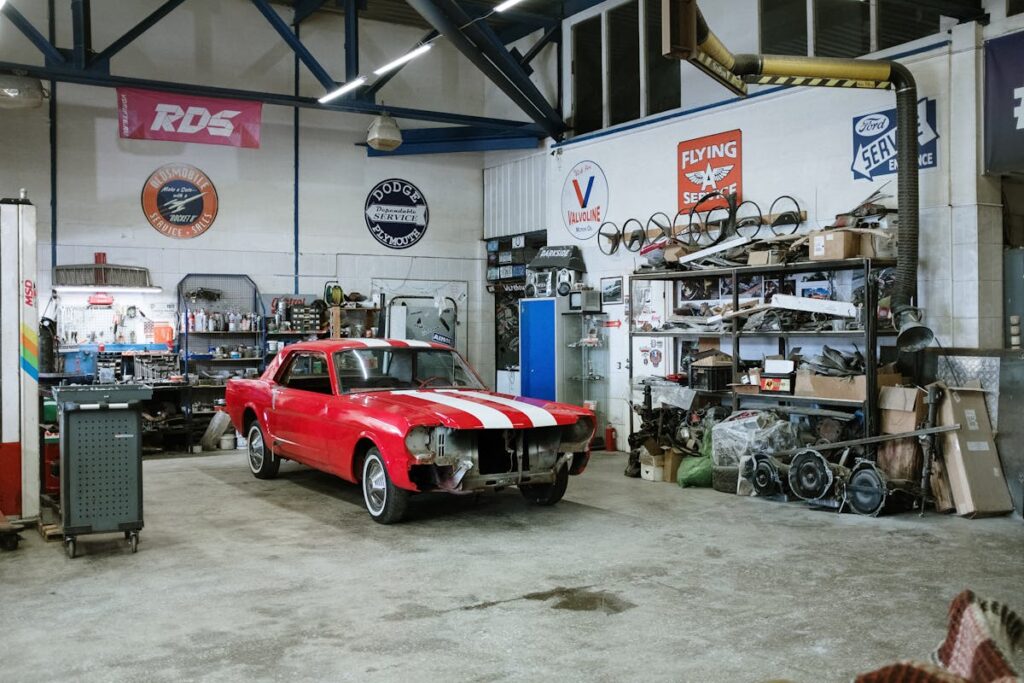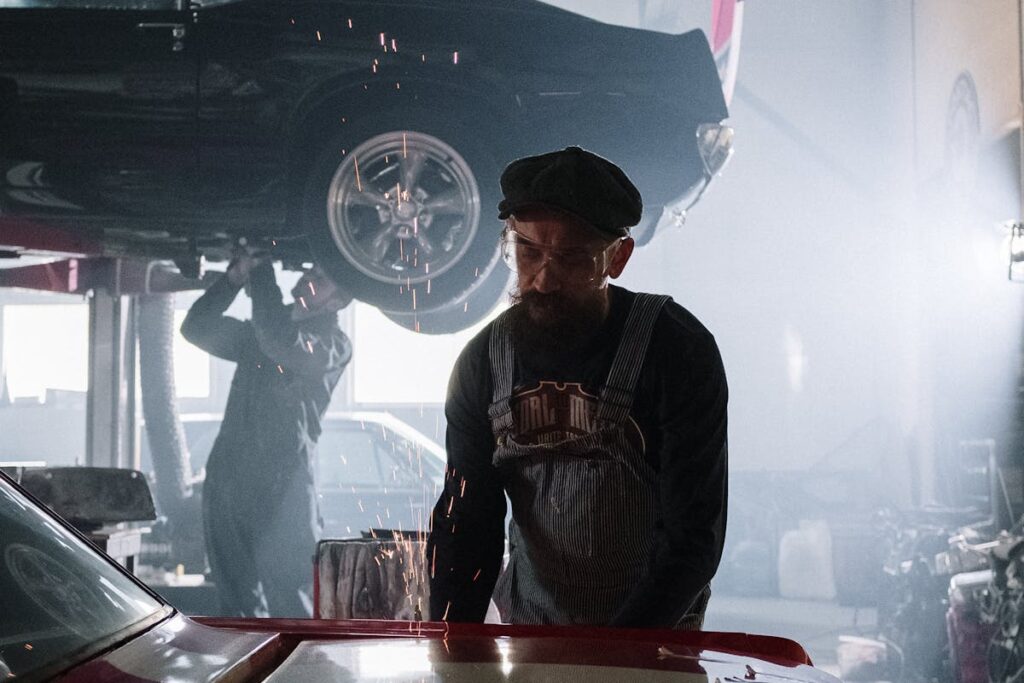The resurgence of interest in classic cars has led many enthusiasts to undertake the intricate journey of restoration. This process, while complex, provides a unique opportunity to revive automotive history and create a tangible piece of art. However, without a thorough understanding of the restoration process, beginners may find themselves overwhelmed. Consequently, this guide aims to demystify the steps involved in restoring classic cars, from evaluation to sourcing parts, bodywork, interior restoration, engine rebuilding, and troubleshooting. As we explore deeper, you’ll discover the meticulous attention to detail and patience required to breathe life back into these timeless machines.
Key Takeaways
- Start with a thorough evaluation of the car’s physical condition and historical significance to inform your restoration approach.
- Source necessary restoration parts from suppliers, online marketplaces, or local salvage yards, using manuals and forums for guidance.
- Work on the car’s body and paint, involving rust repair, dent fixing, and applying multiple coats of paint after sanding and priming.
- Restore the interior by evaluating damage, selecting suitable materials, and using precise techniques to maintain the car’s original charm.
- Rebuild the engine meticulously, focusing on cleaning, tuning, and fine-tuning various components, while preserving the engine’s legacy.
Understanding Classic Car Restoration
A vast majority of auto enthusiasts will agree that classic car restoration is much more than a hobby or pastime – it’s a passion that requires an intricate understanding and appreciation for automotive history and engineering. The process of bringing a vintage vehicle back to its original glory is a journey that begins with a deep understanding of the car’s make, model, and year, followed by a careful evaluation of its current condition.
Restoration techniques vary greatly depending on the car’s age, rarity, and the owner’s ultimate goal for the vehicle. For instance, a ‘frame-off’ restoration will involve disassembling the entire car and restoring each part individually, while ‘cosmetic’ restoration focuses on the car’s exterior aesthetics. Regardless of the approach, a thorough knowledge of the car’s original specifications is vital.
Vintage car care also plays a significant role in classic car restoration. This involves regular maintenance, from the engine to the upholstery, to guarantee the car remains in optimum condition. Careful use of appropriate cleaning agents, lubricants, and protective coatings is essential to prevent rusting, cracking, and other forms of degradation. Fundamentally, car restoration marries the love for history with the thrill of engineering, resulting in a rewarding, hands-on experience.
Evaluating Your Classic Car
As we commence on the journey to restore your classic car, the first essential step is thorough evaluation. This involves a meticulous assessment of the car’s physical condition, from the bodywork to the inner mechanics, ensuring every detail is accounted for. Beyond the tangible, understanding the historical significance of your classic car is vital as it adds context and depth to the restoration process, enhancing the vehicle’s inherent value.
Assessing Car’s Physical Condition
Diving into the domain of classic car restoration, a paramount first step is a thorough evaluation of the car’s current physical condition. This evaluation, consisting of rust inspection and analyzing structural integrity, provides an all-encompassing snapshot of the vehicle in its current state.
When checking for rust, inspect the entire car, paying particular attention to the undercarriage, wheel wells, quarter panels, door bottoms, and trunk. Rust can be a silent killer in classic cars, compromising both aesthetics and safety. Use a rust converter or rust encapsulator to halt the oxidation process and prevent it from spreading.
Analyzing the structural integrity involves a detailed check of the car’s frame, suspension, and body panels. Look for signs of previous repairs, misalignment, or damage that could impact the car’s performance or safety. Using a magnet can help identify areas where filler may have been used to cover damage.
Restoring a classic car is a labor of love and requires meticulous attention to detail. A thorough physical evaluation lays the groundwork for a successful restoration project, helping you understand the extent of the work ahead and planning accordingly. Remember – the beauty of a classic car is not just skin deep, but lies in its structural soundness too.
Understanding Historical Significance
Evaluating your classic car goes beyond the domain of physical assessment; it also involves understanding its historical significance. There’s a profound sense of satisfaction in recognizing how your vehicle fits into the larger tapestry of the automotive heritage. It’s not just about the make, model, or year – it’s about the cultural impact that the car had during its heyday.
Perhaps your classic car was a symbol of post-war prosperity, or it marked a significant shift in automotive design. Maybe it represents a key development in engine technology or it’s a model that has become synonymous with a particular cultural movement or era. Understanding these factors can dramatically enhance your appreciation of your classic car and can inform your restoration efforts.
Moreover, this understanding adds a layer of depth to your relationship with the car. It can guide your decisions regarding authenticity during restoration, and it can even influence the value of the car in the classic car market. Hence, the historical significance of your classic car does not only speak of its automotive heritage but also its cultural impact, turning your restoration project into a preservation of history.
Sourcing Necessary Restoration Parts
A restorer’s journey to bring a classic car back to life is often punctuated by the quest to source necessary restoration parts. This pursuit is a essential aspect of the restoration process, and it involves meticulous research and careful selection.
With the advancement of technology, enthusiasts can now access a plethora of sources to find the parts they need, both original components and aftermarket parts. Restoration suppliers are a reliable source, with their extensive collection of parts for various car models. These suppliers often provide parts that are hard to find, making them a significant resource for restorers.
Online marketplaces are another valuable source. Many individuals and businesses sell parts on these platforms, offering a wide range of options. Additionally, local salvage yards can be treasure troves of vintage parts, especially for those who enjoy the thrill of the hunt.
For guidance on what parts are needed and how to install them, restoration manuals and vintage catalogs are invaluable. They not only provide detailed instructions but also give insights into the car’s history. Finally, community forums are another excellent resource. Here, seasoned restorers and fellow enthusiasts share tips, advice, and parts sources, fostering a supportive network for beginners.

Working on Body and Paint
Once the necessary restoration parts have been secured, the spotlight shifts to the body and paintwork of the classic car. This stage is critical as it directly influences the car’s aesthetic appeal and overall value. The process begins with a thorough body repair, addressing any dents, rust, or damage that has occurred over time. This work requires a skilled hand and a keen eye for detail to guarantee that the vehicle maintains its original lines and symmetry.
After the body repair, the car’s surface must be meticulously prepared for painting. This paint preparation phase includes sanding to remove old paint and smoothing out any imperfections. It’s a laborious process, but absolutely essential for achieving a flawless, mirror-like finish that classic cars are known for. Following this, a suitable primer is applied, providing a base for the paint to adhere to while protecting the metal beneath.
The painting process itself demands precision and expertise, often involving several coats to achieve the desired depth and shine. The choice of paint color and finish can either restore the car to its original glory or give it a unique, custom look. The skill and dedication invested in the body and paintwork can truly make the difference between a good restoration and a great one.
Reviving the Classic Interior
Moving beyond the exterior, the heart of a classic car lies in its interior, a space that calls for meticulous evaluation and restoration. It is essential to assess the extent of interior damage in order to determine the materials needed to restore the car’s original charm. Mastering the techniques for restoration, from upholstery to detailing, is an art form that demands precision and passion, transforming the worn into the iconic.
Evaluating Interior Damage
Peering beneath the surface of a classic car’s interior can reveal a treasure trove of information about its past life. Each blemish or tear speaks volumes about the journeys it’s endured, the passengers it’s carried, and the time it’s weathered. However, these signs of wear and tear can also indicate the extent of interior damage that needs addressing during a restoration project.
Evaluating interior damage involves inspecting different interior materials for signs of decay or damage. Often, upholstery and carpets bear the brunt of wear, showing signs of fading, tearing or staining. Similarly, the dashboard, panels, and trim pieces made of plastic, wood, or metal may show cracks, discoloration, or rust.
Determining the level of interior damage contributes greatly to formulating a realistic restoration budget. Consider hiring a professional appraiser if you lack the expertise to accurately assess the damage. They will provide an in-depth evaluation and help you anticipate the cost of restoring each element to its former glory.
Choosing Suitable Materials
The process of selecting suitable materials for restoring a classic car’s interior is both an art and a science. The key lies in understanding the intricate balance between maintaining the vehicle’s authentic charm and ensuring modern-day comfort and safety.
Material durability is a prime factor to evaluate. Classic automobiles often utilized materials that, while authentically attractive, may not withstand the test of time or everyday use. Hence, one may need to opt for modern, more durable materials that mimic the look and feel of the original. Leather, for instance, provides an excellent blend of classic appeal and durability. High-quality synthetic materials, such as vinyl, offer a more cost-effective option without compromising too much on aesthetic appeal.
Examine the cost effectiveness of your chosen materials as well. While the restoration of a classic car should not be dictated solely by budget constraints, it’s crucial to find a balance between cost and quality. Opt for materials that offer longevity and aesthetic appeal at a reasonable price.
Techniques for Restoration
While the process of restoring a classic car’s interior can be a challenging endeavor, it is also an opportunity to revive the vehicle’s classic charm. Restoration techniques deployed should be meticulous, aiming to conserve the original elements while adding modern conveniences through vintage upgrades.
The first step in restoration involves a thorough cleaning and examination of the existing interior. This helps identify the areas that require attention and those that can retain their original charm. Special attention must be paid to the seating, as it forms the crux of the interior’s vintage appeal. Traditional materials and methods should be used for repairs, to maintain the classic appeal.
Vintage upgrades, while enhancing the functionality and comfort, should complement the car’s classic aesthetic. For instance, installing a modern stereo system might be desirable, but it should not disrupt the vintage dashboard design.
Restoring the interior of a classic car is a delicate balance of preservation and innovation. It requires a deep understanding of the car’s history, a passion for its heritage, and a vision for its future. With the right approach and techniques, the classic charm can be revived, creating a unique blend of past elegance and present comfort.
Rebuilding the Engine
It could be contended that the heart of any classic car is its engine, a complex marvel of engineering that powers these timeless machines. The process of rebuilding the engine is meticulous and demanding, but the reward is a revived, thunderous heart that breathes new life into your beloved classic.
The first step is to completely disassemble the engine. This process allows you to inspect each part, determine its condition, and decide whether it can be reconditioned or if it needs to be replaced. During this stage, careful cleaning of the engine components is essential to guarantee peak engine performance.
Engine tuning is the next pivotal step. This involves adjusting the engine to achieve the perfect balance between power and efficiency. Fine-tuning the carburetor, timing, and ignition system can markedly improve the performance and longevity of the engine.
Rebuilding the engine of a classic car is not just about enhancing its performance, but also about preserving its legacy. With each component meticulously restored and tuned, the engine’s roar will echo the glory of its past, making the classic car restoration journey a truly rewarding experience. For enthusiasts interested in exploring the history and significance of powerful engines, particularly those in muscle cars, the muscle cars of the 1960s and 1970s offer a fascinating glimpse into the peak of automotive engineering.
Final Touches and Troubleshooting
Having breathed new life into the engine, our restoration journey nears its conclusion with the final touches and troubleshooting.
At this stage, you have brought the car back from the brink, and it is time to make the final adjustments that will see it running like new. This involves carefully checking every bolt and screw, ensuring that everything is secure and in its rightful place. It’s worth noting that these final adjustments can often be the most rewarding part of the restoration process, as you see your hard work come together in a beautifully restored classic car.
Troubleshooting common issues is the last hurdle to overcome. This stage is where your knowledge of the car will truly be tested, as you diagnose and solve any remaining problems. From engine misfires to electrical faults, these issues can range in complexity, but don’t let this intimidate you. With patience and perseverance, you can overcome these challenges and achieve a fully functioning, roadworthy classic car.
Frequently Asked Questions
What Is the Average Cost to Restore a Classic Car?
The average cost to restore a classic car varies widely, typically ranging from $20,000 to $80,000. This restoration budget includes a cost breakdown of parts, labor, paint, and any necessary custom work or modifications.
Can Classic Car Restoration Increase the Vehicles Value?
Absolutely, classic car restoration can greatly increase a vehicle’s value. Restoration benefits include improved aesthetics and functionality, leading to value appreciation, particularly if done meticulously and with respect for the vehicle’s original specifications and era.
What Are Some Recommended Insurance Companies for Classic Cars?
Several insurance companies specialize in classic car coverage. Companies such as Hagerty, American Collectors, and Grundy are renowned for their extensive vintage vehicle policies, designed to protect your investment in these treasured automobiles.
Are There Professional Services for Classic Car Restoration?
Yes, there are professional services that specialize in classic car restoration. These experts utilize various restoration techniques and have extensive resources for sourcing parts, ensuring your vehicle is returned to its original, pristine condition.
How Long Does a Typical Classic Car Restoration Take?
The restoration timeline for a classic car varies based on its condition and project phases. Typically, a thorough, professional restoration can take anywhere from one to three years, demanding meticulous attention to detail throughout each phase.

